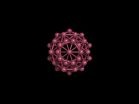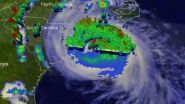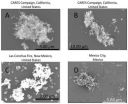(Press-News.org) (BRYAN, Texas) — A new test for tuberculosis (TB) could dramatically improve the speed and accuracy of diagnosis for one of the world's deadliest diseases, enabling health care providers to report results to patients within minutes, according to a study published this week in the journal Angewandte Chemie.
Jeffrey Cirillo, Ph.D., professor at the Texas A&M Health Science Center College of Medicine, in collaboration with GBDbio, a Texas A&M spinoff company, and investigators at Stanford University, have identified a new chemical compound to spot the bacteria that cause TB with a level of sensitivity that currently takes months to produce; and results of the first human clinical trial data are promising. Findings show the test can determine that a patient has tuberculosis with 86 percent sensitivity and 73 percent specificity. Smear microscopy, the most widely used test in the world, has a significantly lower ability to detect TB, ranging between 50 to 60 percent sensitivity.
Although preventable, TB claims three lives every minute, making it the second leading cause of mortality from an infectious disease in the world. Spread through the air when an individual with active TB infection coughs or sneezes, reports show that if left untreated, a person with active TB infects an average of 10 to 15 people each year, leaving a great need for faster, more reliable testing.
Cirillo's latest breakthrough perfects the technology behind the test. Using a fluorescent substrate, the device targets BlaC – an enzyme produced by the bacteria that cause TB – as an indicator of the bacteria's presence. Until now, it has not been possible to target a specific TB enzyme for diagnosis.
Once sputum samples are combined with the reactive substance, a battery-powered, portable tabletop device, the TB REaD™, is then used to detect any fluorescence and deliver the diagnosis in as little as 10 minutes.
"It's simple. Take a sputum sample, treat it with the solution and put it inside the reader," Cirillo said. "A camera inside looks for a reaction between the sample and solution that produces light. No light, no infection."
Currently, there is no diagnostic tool comparable to this and while others exist, they take several months to produce the same level of sensitivity; and come with a high price tag. The latest FDA-approved model cost upwards of $20,000. The target price tag on Cirillo's test is less than $1000 for the reader and less than $5 per test. Additionally, the one-step test will require little technical expertise or resources, should take less than 30 minutes to carry out, and is easily transportable, making it an ideal candidate for field diagnosis in developing countries.
The device significantly undercuts current diagnostic methods, important, given the staggering statistic that if left untreated – a common scenario in countries lacking infrastructure or resources to efficiently screen and follow up with infected patients – a person with active TB has only a 50 percent chance of survival, Cirillo notes.
"Interrupting disease transmission will require early and accurate detection paired with appropriate treatment," Cirillo said. "Our new, rapid point-of-care TB test dramatically reduces the current delays in diagnosis with incredible accuracy, accelerating appropriate treatment and reducing the death rate of the highly infectious disease. We're looking at a low-cost, easy-to-use test that has the potential to eradicate TB."
The test is currently in the later stages of clinical trials with plans to go to market in the next 18 months. Although the first applications will be in TB, Cirillo's detection platform – Reporter Enzyme Fluorescence - could be applied to many other respiratory diseases and infectious agents.
INFORMATION:
The research project, previously published in Nature: Chemistry, has garnered support from the Foundation for Innovative New Diagnostics, the Clinton Health Access Initiative and is supported by the Wellcome Trust.
Low-cost TB test means quicker, more reliable diagnosis for patients
2014-07-07
ELSE PRESS RELEASES FROM THIS DATE:
Platonic solids generate their 4-dimensional analogues
2014-07-07
Alicia Boole Stott, the third daughter of mathematician George Boole, is probably best known for establishing the term "polytope" for a convex solid in four dimensions. Alicia was also a long time collaborator of HSM Coxeter, one of the greatest geometers of the 20th Century.
Platonic solids are regular bodies in three dimensions, such as the cube and icosahedron, and have been known for millennia. They feature prominently in the natural world wherever geometry and symmetry are important, for instance in lattices and quasi-crystals, as well as fullerenes and viruses (see ...
Scientists find important piece in the brain tumor puzzle
2014-07-07
This news release is available in French. Scientists at the Montreal Neurological Institute and Hospital, McGill University and McGill University Health Centre have shown that a member of the protein family known as SUMO (small ubiquitin-like modifier) is a key to why tumour cells multiply uncontrollably, especially in the case of glioblastoma. The SUMO family proteins modify other proteins and the SUMOylation of proteins are critical for many cellular processes. Identifying SUMO's role in the cancer cell growth will lead to a new strategy for glioblastoma treatment. ...
NASA sees Hurricane Arthur's July fourth fireworks on US East Coast
2014-07-07
VIDEO:
On July 3, NASA's TRMM satellite passed over Arthur and saw intense bands of thunderstorms north of Arthur's well defined eye dropping rainfall at a rate of over 98.4 mm...
Click here for more information.
Hurricane Arthur made landfall in North Carolina on July 3, and today, July 4, it is bringing its own fireworks along the Mid-Atlantic and New England states. Those fireworks were in the form of "hot towers," powerful, high thunderstorms with heavy rainfall that indicate ...
Conclusion of the Lindau Nobel Laureate meeting
2014-07-07
The 64th Lindau Nobel Laureate Meeting ended with a panel discussion entitled "Science for the benefit of mankind" on Mainau Island, Lake Constance, Germany, today." 37 Nobel laureates and more than 600 selected young scientists from 80 countries had participated in the week-long meeting in the Bavarian city of Lindau since last Sunday. A boat trip to Mainau at the invitation of the State of Baden-Württemberg marked the finish of the programme which was devoted to medicine and physiology. In 1895 Alfred Nobel determined in his will that the Nobel Prizes shall be awarded ...
New optogenetic tool for controlling neuronal signalling by blue light
2014-07-07
Institute for Basic Science (IBS), the main organization of the International Science and Business Belt project in South Korea, has announced that a group of researchers, led by professor Won Do Heo, have developed a new technology in the field of optogenetics that can remotely control specific receptors by light. They have named this new technology "OptoTrk" and it has succeeded with neuronal differentiation inducement.
The most significant feature of OptoTrk technology is that it requires only light to activate neuronal functions without the need of other substances. ...
Perspective of the PandaX dark matter experiment
2014-07-07
The PandaX experiment of China, which is located in the deepest underground laboratory, has released its technical design report recently. The full article will appear in SCIENCE CHINA Physics, Mechanics & Astronomy, 2014, 57(8): 1476-1494.
The Particle and Astrophysical Xenon (PandaX) collaboration was established in 2009 and mainly supported by the Ministry of Science and Technology, the Ministry of Education in China, the Natural Science Foundation of China,and Shanghai Jiao Tong University. The experiment is suitable for both direct dark matter detection ...
New type of soot particle discovered from wildfire emissions
2014-07-07
RENO – Every year, wildfires clear millions of hectares of land and emit around 34-percent of global soot mass into the atmosphere. In certain regions, such as Southeast Asia and Russia, these fires can contribute as much as 63-percent of regional soot mass.
In a paper published in Nature Scientific Reports, a team of scientists led by Rajan Chakrabarty from Nevada's Desert Research Institute report the observation of a previously unrecognized form of soot particle, identified by the authors as "superaggregates," from wildfire emissions. These newly identified particles ...
Blocking cells' movement to stop the spread of cancer
2014-07-07
Insights into how cells move through the body could lead to innovative techniques to stop cancer cells from spreading and causing secondary tumours, according to new UCL research.
Scientists discovered that cells can change into an invasive, liquid-like state to readily navigate the narrow channels in our body. This transformation is triggered by chemical signals, which could be blocked in order to stop cancer cells from spreading.
Most cancer deaths are not due to primary tumours, but to secondary tumours in vital organs, such as the lungs or brain, caused by cells ...
Do you look infected? Should I kill you? No, I'm fine, move along
2014-07-07
Some viruses can hide in our bodies for decades. They make 'fake' human proteins that trick our immune cells into thinking 'everything is awesome', there's nothing to see here.
Now researchers at the Imaging Centre of Excellence at Monash and Melbourne Universities have determined the basic structure of one of the two known families of these deceptive proteins.
Using synchrotron light and working with a common virus that lives in people happily and for the most part harmlessly, they worked out the structure of the fake proteins. This is an important first step towards ...
NUS researchers discover novel protein complex with potential to combat gastric cancer
2014-07-07
A team of scientists from the Cancer Science Institute of Singapore (CSI Singapore) at the National University of Singapore (NUS) discovered that a protein named IL23A is part of our stomach's defence against bacterial infection which leads to gastric cancer. This finding could potentially be used to combat the deadly disease.
The research group, led by Professor Yoshiaki Ito, Senior Principal Investigator at CSI Singapore, also showed that the production of IL23A by stomach cells requires the tumour suppressor gene, RUNX3, which is frequently silenced in gastric cancer. ...




